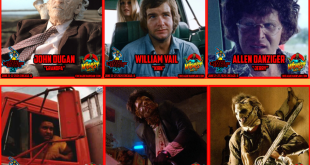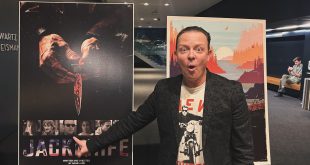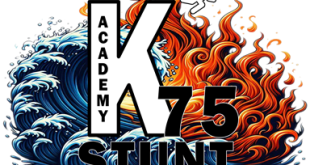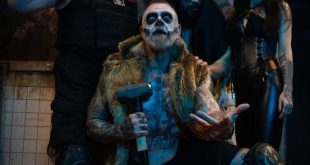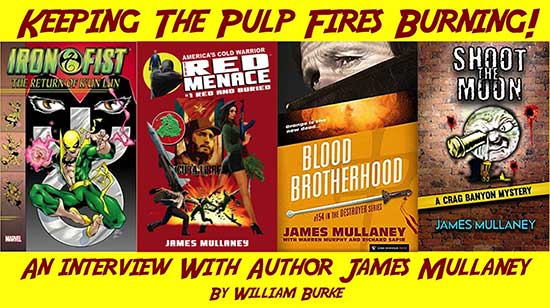
James Mullaney is a literary renaissance man, dedicated to keeping the spirit of pulp literature alive—and I consider the term “pulp” to be high praise. He kick-started his writing career by authoring 26 novels in the popular adventure, semi-superhero series “The Destroyer.” His association with that character carried over to collaborating on a big-screen adaptation with screenwriter Jim Uhis (Fight Club). And, if those demonic entities from “Development Hell” are exorcised, the film will be directed by Lethal Weapon screenwriter, Marvel Universe director, and Destroyer mega-fan Shane Black (Iron Man 3, The Predator).
For the uninitiated “The Destroyer” book series was created in 1971 by Warren Murphy and Richard Sapir. The ongoing saga of reluctant assassin Remo Williams and his Korean trainer Chiun was part of a tidal wave of men’s action series published in the wake of Don Pendleton’s “The Executioner.” But “The Destroyer’s” authors were happy to bite the hand that feeds by satirizing the testosterone action genre. The amount of humor and social commentary snowballed with each book.
That quirky humor helped “The Destroyer” bloom into a pop culture phenomenon, selling over thirty million copies. Along the way it spawned a Marvel Comics series and the love-it-or-hate-it film adaptation, Remo Williams, the Adventure Begins. Sadly, the film’s script discarded much of the book series’ charm and the adventure began and ended with one movie.

“The Destroyer” had been running for nearly thirty years and a hundred and ten books when James Mullaney took the writer’s chair in 1998. Over the next five years he pushed the aging series back onto Amazon’s top seller charts.
Independent of “The Destroyer,” Mullaney created the satirical action series “The Red Menace.” Its five (and counting) novels follow the exploits of 1970s-era, commie-smashing hero Podge Becket. On the purely comedic side he’s also authored nine hilarious “Crag Banyon” novels (and an anthology), chronicling a booze-soaked private eye with a client roster that’s included Santa Claus, leprechauns and Greek gods. And, thanks to Shane Black’s support, the Banyon novels may become a Fox Television animated series.
Jiminy Christmas, that’s a lot of writing! Yet, somewhere amid that writing frenzy, he attained every comic book fan’s dream by working with Marvel on its “Iron Fist: The Return of K’un Lun,” series.
Most recently, he’s revived the classic “Destroyer” book series with Brotherhood of Blood, pitting heroes Remo Williams and Master Chiun against an insidious race of Chinese vampires. Rest assured, the blood sprays and the quips fly in equally generous portions. As a long-time fan, I can tell you it was worth the wait.
I’ll let James Mullaney take it from here.
BB: I understand your transition to becoming “The Destroyer’s” principal writer was very unique in that you submitted a spec novel. Can you share that story?
JM: Let’s see. How to answer that diplomatically. Nope, I can’t. That’s too bad, because it’s a tale full of deceit and sabotage. I can say that it was very lucky I had that spec manuscript. I had something that I could send to Gold Eagle, the publisher at the time, to let them know that I wasn’t the no-talent that they had been led to believe. Maybe I can tell that story on my deathbed. Which could be tomorrow, if I tell that story today.
WB: I’d be remiss not to include the series’ creator Warren Murphy, who, in addition to being a prolific novelist with over 60 million books sold, was also a screenwriter on The Eiger Sanction (1975) and Lethal Weapon 2 (1989). Was he a mentor to you?
JM: Warren wasn’t really a mentor to me. I’d spoken to him only a couple of times while I was working on “The Destroyer” for Gold Eagle. We were friendly, but it was only after I’d finished a 21 book run for them that Warren and I became friends. So, I was something like a million and a half words into a writing career by then. If I still needed mentoring at that point I was in the wrong line of work. But Warren did give me a great compliment once that I don’t think I’ve ever mentioned publicly. I’d sent him a note grousing about something or other, and he said it sounded like his younger self writing to him. There’s no way that doesn’t make you feel good.
I still miss him. I’ll always be upset that he didn’t write an autobiography. It would have been hilarious.
WB: What condition was the book series in when you stepped in—both creatively and sales wise?
JM: “The Destroyer” was pretty old at that point. It’s not a crime to say it. It wasn’t old enough for Medicare, but it was about thirty years old back then. It’s hard to keep reader interest from waning after so much time. I tried to bring it back to what I loved about the series as a kid. The fans responded to that. I got many notes back then from former “Destroyer” readers who came back to the series because of my work. I mention in an introduction to one of the two recent books I did that by the end of my Gold Eagle run I’d dragged the Amazon rankings up to around 120 each time a new book was released. You’re doing something right if you can get a thirty-year-old series to within 119 points of the latest Harry Potter. Avada Kedavra, indeed.
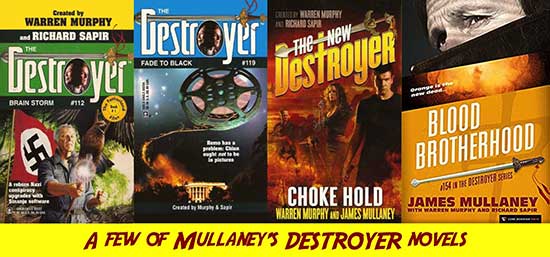
WB: Allowing a single writer to helm an entire series was unusual for publisher Gold Eagle who constantly changed authors on their Mack Bolan books. Did “The Destroyer’s” creator, Warren Murphy, have to fight to retain that creative control?
JM: That was me, actually. At first, they wanted to keep on a couple of writers who did three bridge books between the previous full-time ghostwriter and me. I said no way, which was kind of funny for some little snot-nose just starting out. But I’d seen those books and they were –how do I say this diplomatically? — utter crap. Believe me, any “Destroyer” fans who slogged through those books know that I’m being kind. I told them I didn’t want my good books propping up lousy books. I guess they wanted me to work for them, because they agreed to let me be the solo writer for the next five years.
Interviewer’s note: Mullaney isn’t exaggerating about the bridge books being bad. Legions of “Destroyer” fans would testify to just how terrible books 108-110 were.
WB: As a relatively new author how did you deal with the pressure of writing 21 consecutive novels over a mere five years?
JM: I have no idea how I did it. Not a clue. That is an astonishing output. Many of those books were either approaching or exceeded 90,000 words. I couldn’t do that now if you, unlike Gold Eagle, paid me.
WB: One of the most memorable aspects of the series was the humorous interaction between aged Sinanju Master Chiun and his American pupil Remo Williams. That humor was in previous books, but you honed it to a fine edge while emphasizing their surrogate father/son relationship. Was that aspect of the books a personal favorite of yours?
JM: Very much so. It should be fun playing around with these (or really any) characters. If you’re not having at least some fun as a writer, you can’t expect readers to do the job for you. I hadn’t written a “Destroyer” in thirteen or fourteen years when I did the two recent ones. It was so easy to step back into writing these guys. It is just so much fun to put words in their mouths.
WB: Why did Gold Eagle cease publishing “The Destroyer” while their other less inspired series like “Mack Bolan” and “Stony Man” kept chugging along?
That was Warren Murphy’s doing. He pulled the plug. Warren had signed a final four-year contract around the time I quit, so Gold Eagle did sixteen more books after mine. (What’s a polite way to say “stink out loud?”) Gold Eagle had wanted to continue publishing the series, but after those sixteen literary cowpats, Warren said no way.
WB: How did you become involved with Marvel’s “Iron Fist” series?
JM: I’m terrible, because I don’t remember some things like I ought to. Thirty years from now someone will be giving me a cognitive test, and the only difference between me failing it now and me failing it then is that now I’m not wearing my underwear on my head. I know I’d just finished up my Gold Eagle work on “The Destroyer,” and someone at Marvel who was a fan of my books found out I was free. They contacted me. I remember it was fun because it was so different from anything I’d done before. I also remember it was scary because it was so different from anything I’d done before.
WB: What inspired you to revive the “classic” “Destroyer” novels with Blood Brotherhood?
JM: A cluttered shelf. I had two full-length “Destroyers” that had never been published sitting on my shelf for years. I thought I could give them a quick polish, clear off part of my shelf, and make a couple of bucks. And then I wound up chucking the original Blood Brotherhood manuscript because it was crap, and I wrote a whole new book. Not all at once, of course, because I had to torture myself first. I’d save one line from one chapter, then rewrite that one line. At one point I had 35,000 words that I’d pushed off to the end of the book as I was working on it thinking that there had to be something salvageable in it. Then one day I deleted it all. Just unreadable crap. At least I was able to use some of the original manuscript as a sort-of outline. Outlines are always the hardest thing for me anyway. Everything else is just filling in the blanks.
WB: Blood Brotherhood represents your return to the series after many years. During that period potential readers have been immersed in plot-driven video games like Grand Theft Auto that unspool non-stop action and violence. Likewise, Hollywood now unleashes mega-budget, spectacular super hero movies on a semi-weekly basis. Did you feel the need to address that shortened attention span and slam bang mindset when you were writing?
JM: Nah, I’m too dim to learn new tricks. I just write the way I’ve always written. I mean, hopefully I’ve gotten better at it over the years, but I’ve never written anything other than what I’ve wanted to write. Which is probably why my bank account isn’t bursting at the seams. But since I do what I want, I’m happy with my work. I win.
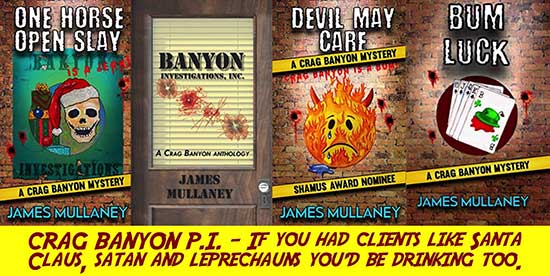
WB: I’m jumping around in time here, so forgive me. I genuinely enjoyed the “Crag Banyon” books. I always felt it was an example of a writer creating freely, without an annoying publisher hovering over him. How did the concept of a classic film noir PI living in an alternate mythological, fairy tale universe come about?
JM: To your point about publishers. They are horrible. I hate them. If I never have to work for another traditional publisher, I will die a happy man. Or at least as happy as you can be when you’re dying, which I imagine is probably a pretty terrible experience. Nearly as bad as working for a traditional publisher.
As for Banyon, he only exists because of another series of mine, The Red Menace. The first or second Menace had just come out, and I wanted a little cheapo short story that I could give away as an ebook that might help promote the Menace. I dug out a story I’d written years before about a reporter investigating a murder at the North Pole. It was pretty poorly written, but the idea was good. It was only supposed to be a one-off about Santa and Mrs. Claus and all the usual Christmas stuff. But at one point early on I needed to get Banyon out of a tough spot I’d put him in. He was in a police interrogation room being questioned by a cop who hates him. Then I thought to have him call not a lawyer, but summon a genie who owes him a third wish. And that opened up everything. Suddenly everything could exist in Banyon’s world. Angels, demons, leprechauns, mad scientists, mermaids, giants. And Banyon just sort of grumbles his rumpled way through it all, the greatest detective in the world who only wants to get the latest case over with so he can get drunk at O’Hale’s Bar.
So, the reporter from that original short story became a detective, and the short story grew into a novella that has now grown into ten published novels, with three more already written in the wings, plus a short story collection. And they’re funny. I’ve read some books that claim to be comic, and they are nearly all terrible. Maybe I’m just not smart enough to get the jokes in those other books. With Banyon, I’m writing comic novels for people who actually like comedy.
The Banyons are the best things I’ve ever written. They’re also the hardest books I’ve ever written, because they’re first-person and Banyon has a very unique voice. So even though they are often torture, they are also a joy to write. I guess that makes me a happy masochist.
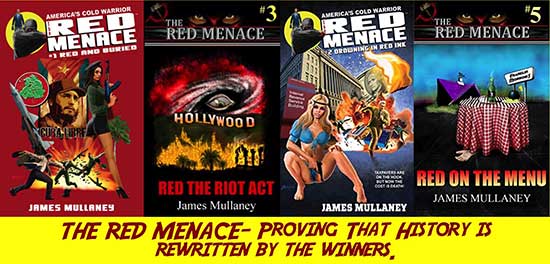
WB: Your action/adventure series “The Red Menace” is unique, in part because it’s a 1970s period piece that doesn’t mind messing with history’s actual timeline. Can you tell readers about the character and how the books came about?
JM: The Red Menace is me writing myself into two eras. First is the men’s action-adventure era of the 1970s. Then there’s the earlier pulp hero age of The Green Hornet, Zorro, The Shadow, etc. My main character is Patrick “Podge” Becket, who was a guy who went up against the Russians at the start of the Cold War. He was a menace to the Reds, hence “The Red Menace.” I’m super-clever like that. Podge went into retirement at the end of the 1950s but comes back out for the first book, which takes place in the early 1970s. He has to come back because he is, of course, the only man on earth who can stop the villain. Then more bad guys start showing up, and he winds up staying on the job. But he can’t do it alone. He’s assisted by his chronically annoyed best friend, Dr. Thaddeus Wainwright. Wainwright is a medical genius who patches Podge up when necessary. He’s also had a hand in pretty much every great scientific achievement in human history, including the formula that keeps the Menace in the game long after a normal man would have had to retire. He also may or may not be immortal. Wainwright is great fun to write, and I’ve barely scratched the surface with him.
WB: What does the future (or is it the past?) hold for “The Red Menace”?
JM: I hadn’t written a new Menace in a bunch of years. I’ve done two more now that are waiting in the wings: Red Devil and Ruses are Red. In the meantime, the original five Menaces are in the process of getting makeovers. New interior formatting and new cover art. Four of those books had never been released in paperback, but that’s about to change, as well. Bold Venture Press has the rights now, and will be releasing them all. #2, Drowning in Red Ink is already out. The rest, hopefully soon after. That’s the plan, anyway. I don’t know how many more I have in me, but I do hope to write more Menaces. But sales will dictate that. All I can do is write the best books I can and hope that they find an audience.
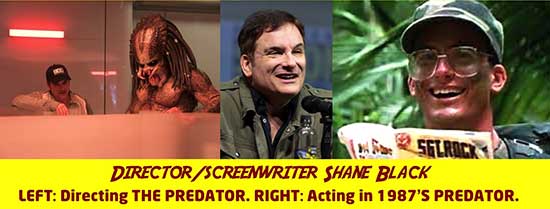
WB: Shane Black seems to be a genuine fan of “The Destroyer” and ’70s-era action/adventure novels in general. He even created an Amazon pilot adapted from the western book series “Edge” which were billed as ‘The most violent westerns in print.’ How did you and Black cross creative paths?
JM: A fan told me that Shane liked my Destroyer work. I wasn’t sure I believed it, but then I found out that it was true in the most boring way possible that I won’t share. Not because it’s some big secret, but because it would put you to sleep. The funny thing is that the first time Shane and I ever spoke he read some Crag Banyon at me, not The Destroyer. I think it was the second one, Devil May Care. Then he told me that someone who writes dialogue like that should be writing movies. If Shane Black says that to you, you should probably listen. So, thanks to Shane, I’m doing that sometimes now, too.
WB: Where is “The Destroyer” film currently at?
JM: Your guess is as good as mine. I don’t know if I’m supposed to say I’m no longer on the project. I’m not. I was on it for six years. I got paid. So that part was good.
WB: What’s next on your seemingly overflowing creative plate?
JM: It’s not as overflowing as I’d like. You lose steam in middle age. Still, I wrote two Destroyers earlier this year. The first one has been incredibly well-received by fans. The next one, Trial By Fire, should be out soon. I just finished the first draft of the thirteenth Crag Banyon Mystery, which I’m almost certain will be titled Simian Says. We’re working on bringing Banyon to TV for Fox. I wrote the pilot episode either earlier this year or late last year. I don’t remember now, I only know it was during the Zoom twilight age. Shane is onboard with that, and we worked on the story together. The two of us will be executive producers if it becomes a series. That’s actually pretty astonishing to be able to say something so cool so casually. Who wouldn’t be happy about all that? Not me, baby.
I want to thank James for taking the time to do this interview. Let’s hope that Fox TV jumps aboard the Crag Banyon PI animated series. Who knows, maybe Banyon has another genie’s wish he can cash in.
 Horror News | HNN Official Site | Horror Movies,Trailers, Reviews
Horror News | HNN Official Site | Horror Movies,Trailers, Reviews
